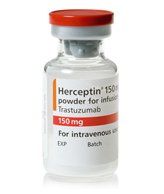Adjuvant Trastuzumab Shows Low Rate of Cardiac Events
An 8-year follow-up of HER2-positive breast cancer patients receiving adjuvant trastuzumab shows an overall low incidence of cardiac events when administered after chemotherapy and radiotherapy.
Adjuvant trastuzumab shows an overall low incidence of cardiac events when administered after chemotherapy and radiotherapy.

An 8-year follow-up of human epidermal growth factor receptor 2 (HER2)-positive breast cancer patients receiving adjuvant trastuzumab shows an overall low incidence of cardiac events when administered after chemotherapy and radiotherapy. Most of the cardiac endpoints occurred during administration of trastuzumab and not during the follow-up period. Most of these events were also reversible, according to Thomas Suter, MD, of the Swiss Cardiovascular Center, University Hospital in Bern, Switzerland, and coauthors. The study update was published in the Journal of Clinical Oncology.
The final results of the international phase III HERA (Herceptin Adjuvant) trial, reported in October 2012, showed that women with early-stage HER2-positive breast cancer who received 1 year of trastuzumab had no difference in disease-free survival compared with patients treated with trastuzumab for 2 years (hazard ratio [HR] = 0.99; P = .86). The overall survival was also similar (HR = 1.05; P = .63).
The 5,102-patient study compared trastuzumab administered for 1 year or 2 years with observation.
In the current analysis, 9.4% of patients discontinued therapy as a result of a cardiac adverse event in the 2-year treatment arm compared with 5.2% of patients in the 1-year treatment arm. Cardiac death occurred in three patients in the 2-year treatment arm. No cardiac deaths occurred in the 1-year treatment arm, and two occurred in the observation arm.
Serious adverse cardiac events, severe congestive heart failure (CHF), and confirmed significant left ventricular ejection fraction (LVEF) decrease were low. Severe CHF was 0.8%, 0.8%, and 0.0% in the 2-year, 1-year, and observation arms, respectively. However, longer drug exposure did result in higher numbers of confirmed LVEF decrease. Confirmed significant LVEF decrease was significantly higher in the 2-year arm vs the 1-year and observation arms-7.2%, 4.1%, and 0.9%, respectively. Of the patients with confirmed LVEF decrease, 87.5% and 81.2% reached acute recovery in the 2-year and 1-year therapy arms, respectively.
At the median follow-up of 3.6 years, cardiac event rates were 4.4% and 0.6% for the 1-year treatment and observation arms, respectively. Similar rates were reported in the National Surgical Adjuvant Breast and Bowel Project B-31 trial, and most of the events were reversible.
Patients receiving trastuzumab as adjuvant therapy can have cardiac events, particularly when the antibody therapy is combined with an anthracycline-based chemotherapy. The relatively low incidence of cardiac events reported in this long-term assessment of the HERA trial, according to the authors, may have to do with patient selection. Patients tended to be younger, have no cardiac disease, had already completed neoadjuvant chemotherapy, and had an LVEF of 55% These criteria are different from those of other adjuvant trastuzumab trials in which patients were randomly assigned therapy prior to adjuvant chemotherapy and had lower LVEF thresholds (about 50%) at the time of study entry, the authors stated.
In this trial, more than 94% of patients in all three arms did receive an anthracycline-based chemotherapy, but the interval between the chemotherapy and start of trastuzumab therapy was relatively long-a median of 15.3 weeks-compared with other pivotal trials in which the gap between therapies was about 3 to 4 weeks.
“These findings are reassuring for patients with HER2-positive early breast cancer receiving adjuvant trastuzumab,” stated the study authors. Still, they emphasize that “despite this low incidence of cardiac toxicity in our trial, patients treated with adjuvant trastuzumab should have a cardiac assessment before and during its administration to ensure the early detection of cardiac events and prompt treatment.”